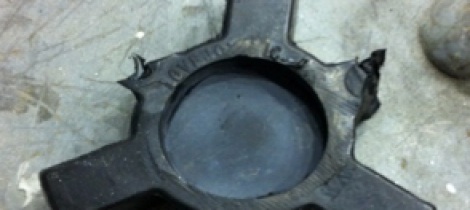Flexible couplings so named for a reason – they are designed to flex. This flexibility allows for slight amounts of misalignment, as well as compensating for slight degrees of shaft axial movement, serving as a “weak link” between the driving and driven machines, and sometimes to absorb torsional forces during startup.
That being said, if too much misalignment exists, and the coupling is taxed beyond its ability to compensate for slight amounts of misalignment, the remaining forces are transmitted to components that are not flexible – namely seals, bearings, and shafts.
The coupling insert in the above photo is supposed to have six “legs”, but three have sheared off due to excessive misalignment – after only a few weeks of operation. If this coupling had been left in place, and the machine not aligned, the forces from misalignment would have continued to be transmitted to the shafts.
Probably the next components to fail would have been the mechanical seal and oil seal, due to excessive radial loading caused by misalignment. If left, fluid leakage and radial loading would have severely reduced the life of the bearings. The damage to the bearings can easily ruin the shaft. Not to mention production outages.
All of this can be prevented by taking a few minutes to accurately align the shafts before placing this machine into operation.
For you would like more information, contact me at stan.riddle@vibralign.com or visit vibralign.com





Comments